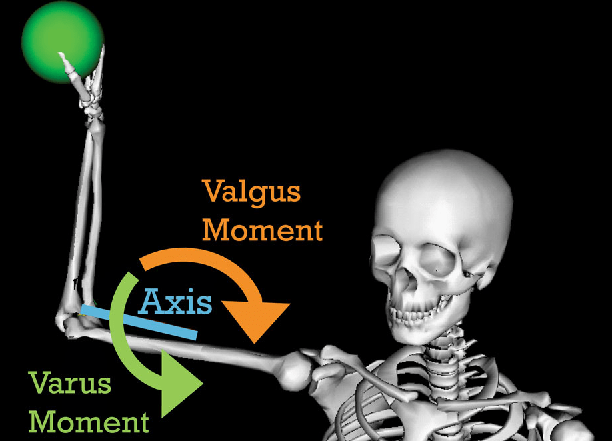Pulse Throw: What do these numbers mean?
Baseball has now become rich with technology, which means data is abundant. However, the data isn’t valuable unless you understand what it’s describing. The Pulse sensor is a tool that provides a lot of data and could be overwhelming if it is not fully understood.
The purpose of this piece is to discuss some updates we made to metric definitions in the Pulse Throw iOS application and to clear up any muddy waters around the Pulse outputs so that you can put this useful data to work.
Let’s walk through each of the live data metrics.
Pulse Throw Live Data Metrics
Elbow Torque: Total estimated torque on the medial aspect of the elbow
- Units: Newton-meters (Nm)
- Explanation: Torque is just a force that causes rotation. The same way the axle of a car applies a torque to the wheel to turn it, think of the humerus (the upper arm) applying torque to the forearm to rotate it toward the plate and deliver a throw. This stress is placed on the medial side (the inside) of the elbow, which includes the UCL, and is called the elbow varus moment, shown in the below graphic.
- Other notes: This is not the load placed directly on the UCL; many other muscles and other tissues counteract this torque to protect the UCL. However, the fatigue of these supporting tissues could lead to additional stress being placed on the UCL.
Picture from Buffi et al. 2014
Arm Slot: The angle between the forearm and the ground at ball release
- Units: Degrees
- Explanation: When the forearm angle is even with the ground, that is a zero degree (side-arm) arm slot. If the forearm extends above the ground, so the wrist is higher in space than the elbow (over-the-top or three-quarters), that is a positive arm slot. A negative arm slot refers to when the wrist is lower in space than the elbow at ball release (submarine). A three-quarters arm slot would be 45 degrees.
- Other notes: If the torso is laterally tilted (side bend) at ball release, it will affect the overall orientation of the forearm, thus affecting the arm slot measurement.
Arm Speed: The peak total rotational speed of the forearm during the throw
- Units: Revolutions per minute (RPM)
- Explanation: There are three axes of rotation for any object in space, so we measure the magnitude of rotational velocity in all three for the forearm to calculate peak arm speed.
- Other notes: This is not the velocity of shoulder internal rotation or elbow extension—both of these measurements contribute to the total arm speed but don’t paint the whole picture.
Shoulder Rotation: The angle between the forearm and the ground at maximum external rotation of the shoulder—represents maximum external rotation
NOTE: Shoulder Rotation is now deprecated and not shown in the PULSE Throw app. See this post for more details.
- Units: Degrees
- Explanation: Maximum external rotation of 180 degrees would be when the forearm is parallel to the ground. Less than 180 degrees of shoulder rotation is when the forearm does not reach parallel with the ground. More than 180 degrees of shoulder rotation is when the forearm passes parallel, so the wrist is lower in space than the elbow.
- Other Notes: If the torso is anteriorly tilted (forward or backward bend), it will affect the overall orientation of the forearm, thus affecting the maximum shoulder rotation measurement.
Now that we know what each of these metrics represents, they can each be used in different ways to aid pitching training and development:
|
Arm Stress |
Arm Slot |
Arm Speed |
Shoulder Rotation |
|
Monitor intent Evaluate throwing efficiency |
Pitch design Monitor fatigue |
Monitor intent Evaluate readiness |
N/A (Deprecated) |
As we can see, there are many training and assessment applications for Pulse when you have the proper knowledge of each metric.
This includes both long-term monitoring of training progress and short-term evaluation, such as monitoring intent of a low-intensity bullpen session with Arm Speed or designing a pitch by adjusting Arm Slot at release. A good example of how the Arm Stress metric has been used is monitoring workload to better understand long-term throwing fitness.
Using Elbow Torque to calculate workloads
An individual’s daily workload can be calculated using the sum of all elbow torque values throughout a day. This is provided in the Pulse DASH and Pulse Throw to estimate readiness for throwing workouts by comparing long-term daily workloads to recent daily workloads. This is an entire additional application that can open many doors to properly on-ramping and managing pitchers’ overall workloads. More importantly, it is a good example of how these metrics can be used for longer-term player development initiatives.
With a mobile and reliable way to evaluate throwing characteristics, there are endless opportunities to grow player development programs. A big obstacle for objectively changing mechanics has been the ability to measure them. With Pulse Throw, we can start tackling this obstacle piece by piece with affordable access to the measurement of athletes’ throwing characteristics.

Comment section